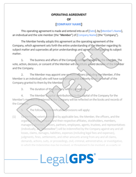Trademarks Made Easy: 7 Steps Every Business Should Follow
This guide--part of our intellectual property series--helps you determine if you should register your mark for trademark protection. You’ll want to...
4 min read
LegalGPS : Oct. 14, 2024
If you've ever taken out a mortgage or a car loan, you’re probably familiar with misleading solicitations that urge you to "ACT NOW" or claim to be a "final notice" about your loan. When you apply for a trademark, expect similar tactics from private companies.
These companies will often contact you, urging you to pay them for services like keeping your trademark application alive or expediting your process. They might sell you services to appeal your application, sometimes long before such an appeal would even be necessary (if ever). They may also offer a so-called "guarantee," even though no such guarantee exists. Many of these services are inaccurate or misleading, and they often contain false claims.


Legal GPS Pro
Protect your business with our complete legal subscription service, designed by top startup attorneys.
Solicitations can look convincing, sometimes including your trademark serial number or other official-looking information. To protect yourself, it’s essential to recognize these solicitations and know exactly how to handle them.
To make sure any correspondence you receive about your trademark is legitimate, follow these actionable steps:
Check the Sender's Email: Official emails from the USPTO will always come from a "@uspto.gov" domain. Be wary of anything else. Fraudulent emails often use similar-looking domains to trick you, such as "@uspto-trademark.com." Double-check the sender’s address closely.
Use the Trademark Status and Document Retrieval (TSDR) Tool: Visit the USPTO's Trademark Status and Document Retrieval (TSDR) tool and search for your trademark application to verify if there are any updates or actions required. This is the most reliable way to check the status of your trademark. Bookmark this page for easy access whenever you need to confirm updates.
Contact the USPTO Directly: If you're unsure whether a solicitation is official, call the USPTO at 1 (800) 786-9199. Explain that you received questionable correspondence, and they will confirm whether it’s legitimate. Keep this number saved in your phone for quick reference.
Check for Official Markers: Look for key indicators that the correspondence is from the USPTO, such as:
Return Address: The USPTO is located in Alexandria, VA. If the return address is different, it may be a scam.
Government Seal: Official USPTO correspondence will often include a government seal. Compare the seal to known USPTO images to confirm authenticity.
Verified Phone Numbers: Check if any contact phone numbers match those listed on the official USPTO Contact Page. Fraudulent letters may include unverified numbers.
Read the Fine Print: Fraudulent solicitation letters often include disclaimers or small-print language that reveals their true nature. Phrases like "This is not an official government document" or "This service is not affiliated with the USPTO" are red flags. Always read the entire document, especially the fine print at the bottom.
Watch for Red Flags in Language: Be cautious of exaggerated urgency, like "FINAL NOTICE" or "URGENT RESPONSE REQUIRED." Official USPTO communications are professional and straightforward, without sensational language. If the tone feels pushy or threatening, it’s probably not from the USPTO.
Master Intellectual Property for Business Success
If you believe you’ve received a fraudulent solicitation, follow these steps to protect yourself:
Do Not Respond or Pay: Avoid responding to or paying any money requested by the sender. Engaging with fraudulent solicitations can put you at risk for further scams.
Report the Solicitation: Report the suspicious communication to the Federal Trade Commission (FTC) or forward the email to the USPTO at TMScams@uspto.gov. This helps authorities take action against fraudsters.
Keep Records: Save any correspondence you receive, including emails and letters. Keeping records can help if you need to prove the solicitation was fraudulent.
You’re likely to receive even more solicitations once the USPTO starts communicating with you during the review process. This happens because trademark applications become public records, making your contact information accessible to third-party companies. These companies monitor the USPTO database and use this information to target applicants with misleading offers.
Being aware of this and knowing what to look for will help you avoid falling for these scams.


Legal GPS Pro
Protect your business with our complete legal subscription service, designed by top startup attorneys.
Imagine you’ve just submitted a trademark application for your new business, and within weeks, you start receiving letters urging you to pay to "finalize your trademark registration" or "expedite processing." These letters look official, often including your trademark serial number and a due date for payment.
One entrepreneur, Jessica, applied for a trademark and received a letter that looked urgent, stating she needed to pay $950 to avoid losing her trademark rights. Before paying, Jessica checked her email history and noticed there was no official USPTO communication about this fee. She used the TSDR tool and confirmed there were no pending actions. This saved her from spending money on a fraudulent service.
Always take the time to verify before acting. Fraudulent solicitations prey on urgency and confusion—taking a step back to check official channels can save you time, money, and headaches.
Be on guard for suspect phone calls, letters, or emails. Scammers may even call pretending to be from the USPTO and request immediate payment or personal information. Remember, the USPTO will never ask for your credit card information over the phone.
Wasting time, money, or energy on irrelevant solicitations is the last thing you want when dealing with your trademark application. By staying informed and following these actionable steps, you can protect yourself and keep your trademark journey smooth.
The biggest question now is, "Do I need a business lawyer?” For most businesses and in most cases, you don't need a lawyer to start your business. Instead, many business owners rely on Legal GPS Pro to help with legal issues.
Legal GPS Pro is your All-In-One Legal Toolkit for Businesses. Developed by top startup attorneys, Pro gives you access to 100+ expertly crafted templates including operating agreements, NDAs, and service agreements, and an interactive platform. All designed to protect your company and set it up for lasting success.

Legal GPS Pro
Protect your business with our complete legal subscription service, designed by top startup attorneys.

100+ legal templates, guides, and expert advice to protect your business.
Trusted by 1000+ businesses

This guide--part of our intellectual property series--helps you determine if you should register your mark for trademark protection. You’ll want to...

If you've successfully filed a trademark application, congratulations—you've completed an important step in securing your brand. But to maintain your...

Registering a trademark in the United States can seem like a complex process, but breaking it down step by step makes it much more manageable. This...